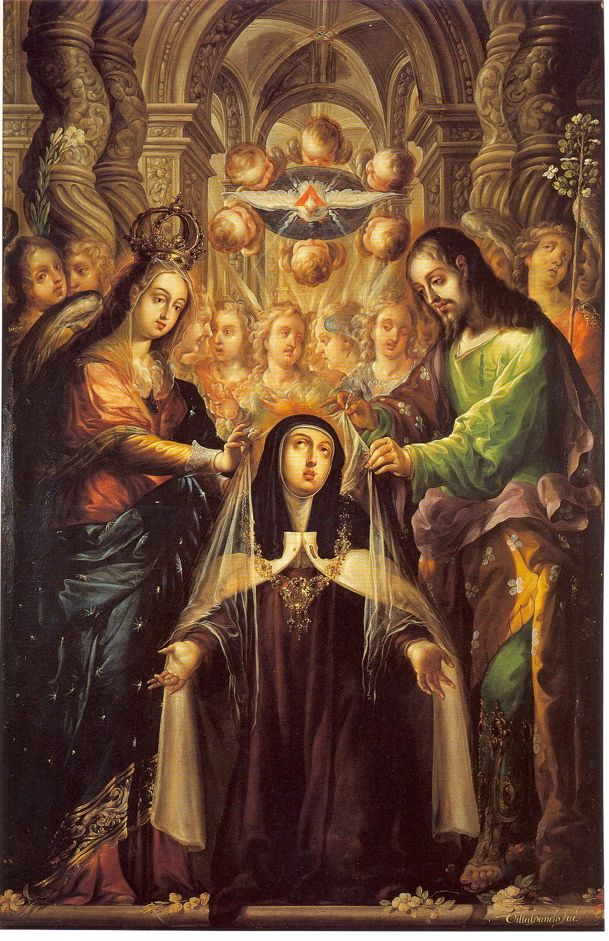St Teresa's whole Marian experience is found scattered throughout her writings, from which we can put together a lovely mosaic of Mary. We will make use of three important traits of Teresian doctrine. a) Devotion to Mary and Marian mystical experience From the first page of Teresa's writings the Virgin Mary appears among the most important memories of her childhood. She recalls the devotion taught her by her mother Beatriz, which found expression in the recitation of the Rosary(8). The episode of her prayer to Our Lady after the loss of her mother at the age of 13 is very moving: "in my affliction I went to an image of our Lady and begged her with many tears to be a mother to me. It seems to me that though I did this in simplicity, it has been of much help to me; for I know that I have always found favour with this sovereign lady when I have commended myself to her and in the end, she has drawn me to herself"(9). Teresa then attributes to the Virgin the grace of a constant protection and in a special way the grace of her conversion: "She has drawn me to herself." Other texts from the autobiography reveal to us the permanence of the devotion to Mary: when she turns to the Virgin in her sufferings(10), when she remembers her feasts of the Assumption and the Immaculate Conception(11) or the Holy Family(12) or her devotion to the Rosary(13).
Very quickly the devotion to the Virgin, like other aspects of the Saint's life, passed into an experience of her mysteries, when God made Teresa enter into contact with the mystery of Christ and all that pertains to it. In Teresa's mystical experience of the mystery of Our Lady there is, as it were, a progressive penetration into the most important moments of the Virgin's life, as we find it in the Gospels. Thus, for example, we have an intuition of the mystery of the overshadowing of the Virgin and of her humble and wise attitude at the Annunciation(14). We know of at least two mystical experiences Teresa enjoyed connected with the first words of Mary's canticle, the Magnificat(15) which, according to the testimony of Mary of St Joseph, Teresa used to repeat frequently "softly, in Castilian"(16).
She contemplates with amazement the mystery of the Incarnation: "The Lord wills to enter into the womb of his most holy Mother. Such is the Lord, he brings liberty with him, and thus he loves to make himself like us"(17). She contemplates the presentation of Jesus in the temple and finds the meaning of Simeon's words to the Virgin(18): "Do not think that when you see my Mother holding me in her arms, she enjoyed this happiness without grave torment. From the time that Simeon spoke these words to her, My Father gave her clear light whereby to see what I would have to suffer"(19). She thinks about the flight into Egypt and the hidden life of the Holy Family(20).
She had a special intuition of the presence of Mary in the paschal mystery of her Son, on the pain of her desolation and the joy in the Lord's resurrection. Teresa loved to contemplate Mary's fortitude and her communion with Christ at the foot of the Cross(21). In Concepts of the Love of God she describes the Virgin's attitude: "She was up, and not sleeping, but suffering in her most holy soul, dying a cruel death"(22). She had entered mystically into the sorrow of the Virgin when the Lord was placed in her arms "as it is portrayed in the fifth sorrow"(23) and had experience at Easter in Salamanca in 1571 of desolation and anguish (a dark night of the spirit) which made her remember the loneliness of the Virgin at the foot of the Cross(24). On this same occasion the Lord said to her, "On my resurrection I went to our Lady who was in great need.... and I stayed long with her for she was in very great need of consolation"(25).
On various occasions it was given to her to contemplate the glorification of the Virgin on the feast of her Assumption(26). She was conscious that the Virgin always accompanied the community at prayer with her constant intercession, as happened at St Joseph's in Avila(27) and at the Incarnation(28).
When it was given to her to know the mystery of the Trinity she perceived the closeness of the Virgin to this mystery, and the fact that the Virgin, along with Christ and the Holy Spirit, are the ineffable gifts of the Father: "I have given you my Son and the Holy Spirit and this Virgin. What can you give to me?"(29) It can be stated that the Holy Mother had a profound mystical experience of Mary, that she enjoyed her presence. Teresa also experienced the mysteries of Mary's life. Consequently in Teresa's doctrine there runs a deep conviction that the mysteries of the Humanity of Christ and those of his Virgin Mother form part of the mystical experience of those tending to perfection(30). (Read More)
 |
| The Holy Mother St. Teresa receives a veil and necklace from Our Lady and St. Joseph |














.jpg)






3 comments:
I just placed an order w/ Amazon.com to purchase 3 of your novels! I'm so excited! This will be my "summer reading"! :)) I'm really looking forward to delving into this historical fiction! God bless you! :))
Thank you so much, ML. Enjoy!!!
This post was very much appreciated - thank you and happy feast day!
Post a Comment